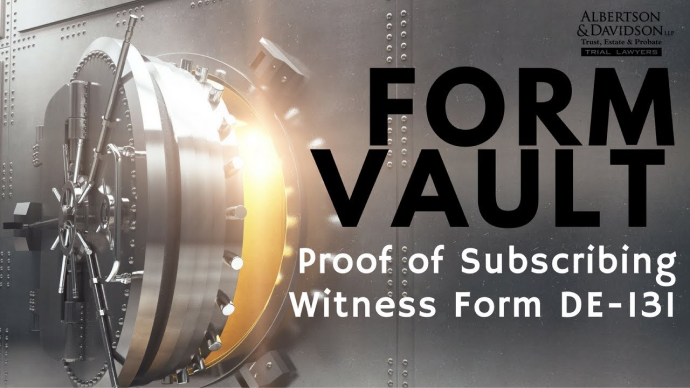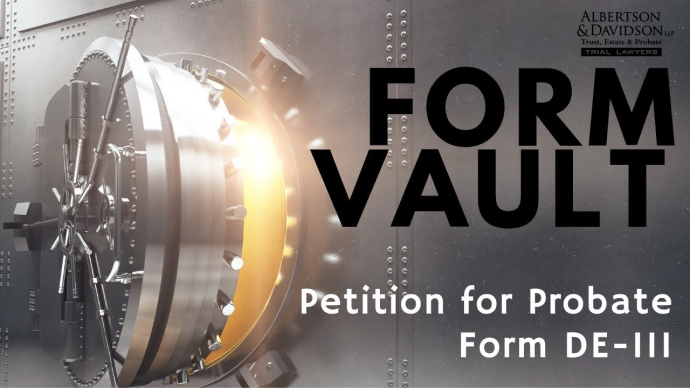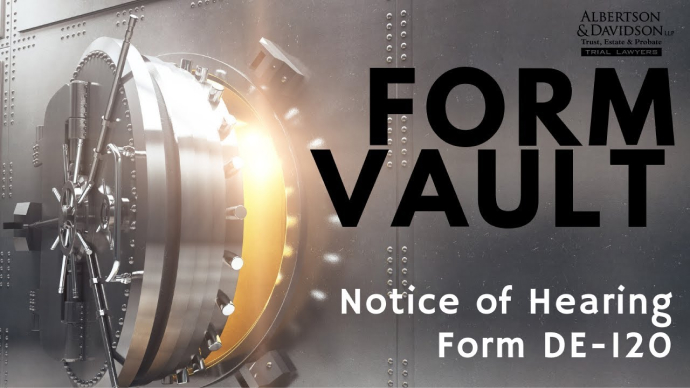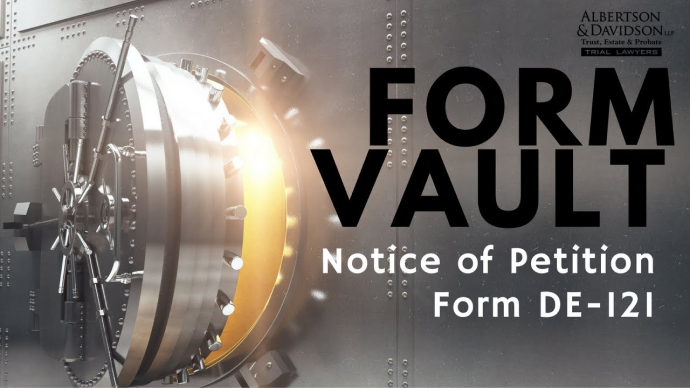Video Transcript
The following is an unedited, verbatim transcript of our video. It is not intended to be a stand-alone article.
Hi, this is Keith Davidson of Albertson & Davidson. In this video, we’re going to go over Form DE-131, which is the Proof of Subscribing Witnesses. So in this series we’ve been starting of by going over the documents that you need to file along with your petition for probate. And what we’re going to talk about in this video, you may or may not have to file depending on the type of will you have. So first of all, if you’re filing to open a probate for decedent who died without a will, then you’re not going to need this form because you’re not asking that will be admitted to probate, and so there is no will, and so you can completely skip this form and this video. If you are asking the court to admit a will to probate, then the question becomes, “Well, is it the type of will that has what we call a self-proving affidavit in it or does it not?”, and that’s going to determine whether you need this form or not. So, let’s walk through and I’ll show you exactly what that means.
So, we always start of at Google, we do a search for judicial council forms and we can go straight to the judicial council website, popped down here to our probate forms – decedents estates, and see the form. This is the type of form that a lot of people aren’t aware of, so we’re going to DE-131, proof of subscribing witness. A lot of people won’t even know that they need this until they file their petition for probate, and then right before the hearing, they’ll get a note, the court puts out probate notes, so you can look up on the court website, and, the court might say, the will’s not self-proving, therefore, proof of subscribing witness is required. And that’s usually the first time that somebody learns of this form or even that there’s a problem, because it’s kind of a sneaky issue, it’s easy to miss. And then all of a sudden you’ll be scrambling, you’ll be saying what’s that even mean and what form do I need.
So let’s go to the form, this is the form here. Let’s talk about why you would need this form. So, I’m going to pop over here to a will, this is an actual will, this is an actual attestation clause that we use in wills when we do wills. And there’s some information in here that is critically important for the court to be able to admit this will to probate. So every will that’s typed out like this, it’s not in the decedent’s own handwriting has to be witnessed by two witnesses in California in order for it to be a valid will. Wills are not notarized by the way. So, notarizing this will wouldn’t help, it wouldn’t have any effect at all, so, skip the notary, you need two witnesses. But look at what the witnesses are saying here, so in this clause, they’re saying that we know Scott Smith, he is an adult, as so is each of us, which is good because to be a witness to a will, you’d be over 18. We watched Scott Smith sign the document. Before signing, Scott Smith declared to us that this was his Will and asked us to serve as witnesses, and the he signed this at our presence, and we signed below in his presence. And that’s important cause the witnesses and the person creating the will, the testator, they have to be all present at the same time in order for the witnessing to be effective, to be legally valid. And then it goes on to say that we understand that this document is Scott Smith’s Will. We believe that Smith was acting voluntarily in signing this Will. We are not aware of any facts that would indicate otherwise. And as far as we are concerned, the people signing, he was not acting under duress, menace, fraud, or of the undue influence of any other person. And then they sign this under penalty of perjury. So, you don’t necessarily have to have all this language in an Will to make it valid, that you could have two witnesses simply witness that Will, saying I witness this Will, and it would still be a valid Will, but if you don’t have this specific language right here that’s signed under penalty of perjury at the end of your will, then you’re going to need this form and the witnesses are going to have to sign a proof of subscribing witness at the time that you try to admit the Will to probate. If you do have this attestation clause at the end of your Will and has this language in it and it’s signed under penalty of perjury, then you won’t need this form DE-131, and believe me, if you can get away from having to do a DE-131, you should do it cause it a pain in the rear. So, most Wills will have this attestation clause, sometimes it will be called a self-proving affidavit. It doesn’t matter what they call it, it’s all the same. This is a self-proving affidavit, and the reason that it’s an affidavit, it because it’s signed under penalty of perjury, that’s all that means. And the reason it’s self-proving, its’ because the witnesses down here, they didn’t just witnessed the Will but they also gave a statement. An affidavit is a statement, a statement under oath. And that statement is we were all together, we were in the same room, we saw Scott Smith signed it, and we weren’t aware of any undue influence, fraud, duress, or menace. And so, that is what makes it a self-proving Will, it has that statement signed under penalty of perjury. So hopefully your will has that. If it doesn’t, you’ll going to be stuck with this form. And the reason why this form is a pain in the rear is because now you have to go out and find those witnesses. Well, you might have a Will that was signed and witness 20, 30, 40 years ago. Who knows, I mean sometimes these Wills are really old. You have to hunt down these witnesses, and the witnesses may not have been people who even knew the testator. I mean sometimes, people go to a bank, or their accountant’s office, or their lawyer’s office, just to sign a Will. And the people witnessing that Will, they’re just kind of a around, and they signed it. They don’t put down their address, they down put down their phone number, and now you’ll have to go out and you’ll have to hunt these people down if they’re even still living and you have to have them sign this form. So you can imagine, it can be a nightmare. So hopefully you don’t need to do this. But if you do then we’ll see what we’re going to do here. So we’re going to do the estate of Rachel Smith. That’s the made up estate we’ve been using. And then you’re going to put in your case number if you have one. If you’re filling this form out before you file your petition for probate which you really should be doing, you should know if you need this form and you should be working on it before you file you petition, then you can just leave the case number blank. You’ll fill that in when you file this along with your petition. And then you have to select the boxes down here which you’re going to have to talk to the witnesses about. So first of all, the name of the decedent was sign in the presence of attesting witnesses present at the same time by the decedent personally. Wills can be signed by another person in the decedent’s presence and by the decedent’s direction. So somebody who doesn’t have the physical ability to sign, they can direct somebody else to sign for them as long as everybody’s present. It’s a little quirk in will creation law but it is allowable.
B, is where a Will was signed outside the presence of a witness which is fine, you can do that but then when the witnesses come together the testator simply acknowledges that I’m the one who signed this, that’s my signature, will you please witness it. So you’re going to choose either A or B. You’re going to have to talk to the witnesses about that. Most of the time it going to be A. Usually the Will was signed in the presence of the witnesses but the witnesses will need to tell you that assuming they even remember. That’ll be interesting.
And the C is the decedent acknowledges in the presence of the attesting witnesses present at the same time that the instrument signed was decedent’s either will or codicil. So you’re always going to check C and if it’s a will or codicil, sometime it’s both, so maybe they made a will and an amendment at the same time. It’s kind of rare but it could happen.
Number 2, when I signed the instrument, I understood that it was decedent’s will or codicil. So the witness has to say that.
And number 3, I have no knowledge of any facts indicating that the instrument or any part of it was procured by duress, menace, fraud, or undue influence. Remember that was the same language we saw over here in the attestation clause. So we are not aware of any facts that would indicate that Scott Smith here was under duress, menace, fraud or under influence. You see how it’s the same language. It’s the exact same language. That’s because it’s doing the exact same thing. And now this proof of subscribing witness has to be signed under penalty of perjury attesting under oath to the facts that are above in this form. Well that’s the same thing happened here on the attestation clause as the witnesses signed under penalty of perjury that these facts stated above are true. So you’ll see that it’s the exact same thing. It’s just that when you have a will with and attestation clause or self-proving clause as they call it, they’re, the witnesses are signing it right then and there at the same time that they witness the will. With this form they didn’t sign it at the time that they witnessed a will and so now you have to go back and get it. And like I said, that can be a challenge. So then you’ll date it, whoever was the witness, you know, Sally opps. So let’s say Sally Smith, well shouldn’t be somebody who’s related, Sally Roberts. Signed it, you’ll put the address and then you’ll have to have that witness sign it if you can find them. So now you’ll see out the attorney’s certification. This is where your attorney will sign saying that I declare under penalty of perjury under the laws of the State of California that attachment one is photographic copy of every page of the will. So remember that the witness is filling out this information relative to the will that you’re submitting to probate. So they’re making facts, they’re stating facts under oath that helps support that will. So that will has to be attached in order to support this form.
So that’s the form DE – 131 proof of support of subscribing witness. I sincerely hope that you don’t need to use this form but if you do, now you know a little something about it and hopefully you know as to why you may need this form and you should check your will before you file your petition for probate because you’ll know based on whether or not it has this type of language in the back and whether or not it was signed by the witness under penalty of perjury. You’ll know if you need this form in advance. And if you don’t see this type of language in your will, you’re going to need this form and so you better get started on it right away because it’s not always easy to find those witnesses. So that’s our review of the form DE – 131 proof of subscribing witness.




